Oymyakon
Oymyakon (Russian: Оймяко́н, pronounced [ɐjmʲɪˈkon]; Yakut: Өймөкөөн, Öymököön, IPA: [øjmøˈkøːn]) is a rural locality (a selo) in Oymyakonsky District of the Sakha Republic, Russia, located along the Indigirka River, 30 kilometers (19 mi) northwest of Tomtor on the Kolyma Highway. It is one of the coldest permanently inhabited settlements on Earth.[4]
Oymyakon Оймякон | |
|---|---|
| Other transcription(s) | |
| • Yakut | Өймөкөөн |
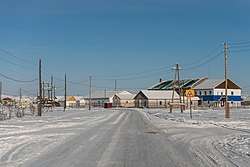 | |
Location of Oymyakon 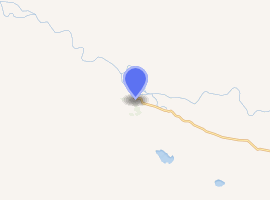
| |
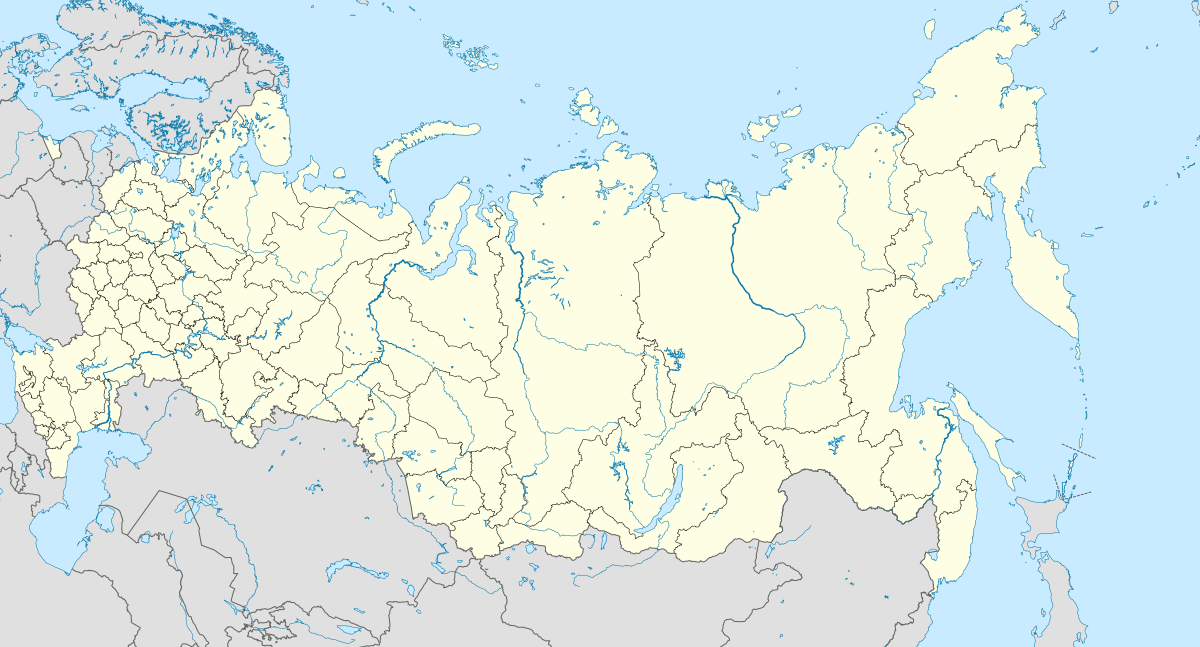 Oymyakon Location of Oymyakon 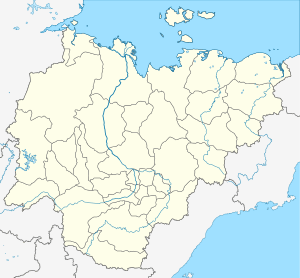 Oymyakon Oymyakon (Sakha Republic) | |
| Coordinates: 63°27′39″N 142°47′09″E | |
| Country | Russia |
| Federal subject | Sakha Republic |
| Administrative district | Oymyakonsky District |
| Elevation | 745 m (2,444 ft) |
| Population | |
| • Total | 462 |
| • Estimate (February 5, 2018)[Videos 1] | 500–900 |
| • Municipal district | Oymyakonsky Municipal District |
| Time zone | UTC+10 (MSK+7 |
| Postal code(s)[3] | 678752 |
| Dialing code(s) | +7 41154 |
| OKTMO ID | 98639405101 |
Etymology
It is named after the Oymyakon River, whose name reportedly comes from the Even word kheium, meaning "unfrozen patch of water; place where fish spend the winter".[5] However, another source states that the Even word heyum (hэjум) (kheium may be a misspelling) means "frozen lake".[6]
Geography
Oymyakon has two main valleys beside it. These valleys trap wind inside the town and create the colder climate.[7] The temperatures here are extremely cold throughout the year, and it snows frequently. Schools are closed if it is colder than −55.0 °C (−67.0 °F).[8]
History
During World War II, an airfield was built in the district of Aeroport, for the Alaska-Siberian (ALSIB) air route, used to ferry American Lend-Lease aircraft to the Eastern Front.[9]
Over the last few decades, the population of Oymyakon has shrunk significantly. The village had a peak population of roughly 2,500 inhabitants, but that number has decreased to fewer than 900 in 2018.[Videos 1]
Climate
With an extreme subarctic climate (Köppen climate classification Dfd/Dwd), Oymyakon is known as one of the places considered the Northern Pole of Cold, the other being the town of Verkhoyansk, located 629 km (391 mi) away by air. The ground is permanently frozen (continuous permafrost).
There is a monument built around the town square commemorating a reading in January 1924 of −71.2 °C (−96.2 °F). This was shown on the Australian program 60 Minutes in a 2012 documentary.[10] On 6 February 1933, a temperature of −67.7 °C (−89.9 °F) was recorded at Oymyakon's weather station.[11][12] This was the coldest officially recorded temperature in the Northern Hemisphere. Only Antarctica has recorded lower official temperatures (the lowest being −89.2 °C (−128.6 °F), recorded at Vostok Station on 21 July 1983).[13][14]
The weather station is in a valley between Oymyakon and Tomtor. The station is at 750 m (2,460 ft) above sea level and the surrounding mountains at 1,100 m (3,600 ft), causing cold air to pool in the valley: in fact, recent studies show that winter temperatures in the area increase with altitude by as much as 10 °C (18 °F).[15]
Some years the temperature drops below 0 °C (32 °F) in late September and may remain below freezing until mid-April. In Oymyakon sometimes the average minimum temperature for December, January, and February remains below −50 °C (−58 °F). Sometimes summer months can also be quite cold, but June and July are the only months where the temperature has never dropped below −10 °C (14 °F). Oymyakon and Verkhoyansk are the only two permanently inhabited places in the world that have recorded temperatures below −60.0 °C (−76 °F) for every day in January.[16][17]
Oymyakon has never recorded an above-freezing temperature between 25 October and 17 March.[18]
Although winters in Oymyakon are long and extremely cold, summers are mild to warm, sometimes hot. The warmest month on record is July 2010 with an average temperature of +18.7 °C (65.7 °F).[19] In June, July and August temperatures over 30 °C (86 °F) are not rare during the day. On 28 July 2010, Oymyakon recorded a record high temperature of 34.6 °C (94 °F),[20] yielding a temperature range of 102.3 °C (184.1 °F). Verkhoyansk, Yakutsk, Delyankir and Fort Vermilion, Canada are the only other known places in the world that have a temperature amplitude higher than 100 °C (180 °F).
The climate is quite dry, but as average monthly temperatures are below freezing for seven months of the year, substantial evaporation occurs only in summer months. Summers are much wetter than winters.
| Climate data for Oymyakon (1981–2010), extremes 1891–present | |||||||||||||
|---|---|---|---|---|---|---|---|---|---|---|---|---|---|
| Month | Jan | Feb | Mar | Apr | May | Jun | Jul | Aug | Sep | Oct | Nov | Dec | Year |
| Record high °C (°F) | −16.6 (2.1) |
−12.5 (9.5) |
2.0 (35.6) |
11.7 (53.1) |
26.2 (79.2) |
31.1 (88.0) |
34.6 (94.3) |
33.1 (91.6) |
23.7 (74.7) |
11.0 (51.8) |
−2.1 (28.2) |
−6.5 (20.3) |
34.6 (94.3) |
| Average high °C (°F) | −43 (−45) |
−35.7 (−32.3) |
−20.8 (−5.4) |
−3.7 (25.3) |
9.1 (48.4) |
20.0 (68.0) |
22.7 (72.9) |
18.1 (64.6) |
8.9 (48.0) |
−9.2 (15.4) |
−31 (−24) |
−42.4 (−44.3) |
−8.9 (16.0) |
| Daily mean °C (°F) | −46.4 (−51.5) |
−42 (−44) |
−31.2 (−24.2) |
−13.6 (7.5) |
2.7 (36.9) |
12.6 (54.7) |
14.9 (58.8) |
10.3 (50.5) |
2.3 (36.1) |
−14.8 (5.4) |
−35.2 (−31.4) |
−45.5 (−49.9) |
−15.5 (4.1) |
| Average low °C (°F) | −50 (−58) |
−47.3 (−53.1) |
−40 (−40) |
−23.9 (−11.0) |
−4.6 (23.7) |
4.0 (39.2) |
6.2 (43.2) |
2.5 (36.5) |
−3.7 (25.3) |
−20.4 (−4.7) |
−39.6 (−39.3) |
−48.8 (−55.8) |
−22.1 (−7.8) |
| Record low °C (°F) | −65.4 (−85.7) |
−67.7 (−89.9) |
−60.6 (−77.1) |
−46.4 (−51.5) |
−28.9 (−20.0) |
−9.7 (14.5) |
−9.3 (15.3) |
−13.2 (8.2) |
−25.3 (−13.5) |
−47.6 (−53.7) |
−58.5 (−73.3) |
−62.8 (−81.0) |
−67.7 (−89.9) |
| Average precipitation mm (inches) | 6 (0.2) |
7 (0.3) |
5 (0.2) |
6 (0.2) |
13 (0.5) |
34 (1.3) |
45 (1.8) |
39 (1.5) |
23 (0.9) |
14 (0.6) |
12 (0.5) |
8 (0.3) |
215 (8.5) |
| Average precipitation days (≥ 1.0 mm) | 3.0 | 2.6 | 1.4 | 1.8 | 3.2 | 6.6 | 8.7 | 7.7 | 5.1 | 4.9 | 4.0 | 3.0 | 52.0 |
| Average rainy days | 0 | 0 | 0 | 0 | 10 | 17 | 17 | 18 | 13 | 1 | 0 | 0 | 76 |
| Average snowy days | 23 | 23 | 16 | 10 | 9 | 1 | 0 | 0 | 9 | 21 | 23 | 20 | 156 |
| Average relative humidity (%) | 75 | 74 | 72 | 68 | 60 | 59 | 65 | 70 | 73 | 79 | 77 | 74 | 71 |
| Mean monthly sunshine hours | 28 | 118 | 244 | 284 | 282 | 304 | 298 | 236 | 151 | 113 | 58 | 13 | 2,129 |
| Source 1: Погода и Климат,[21]February record low[22][23] | |||||||||||||
| Source 2: NOAA (precipitation days and sunshine hours)[24] | |||||||||||||
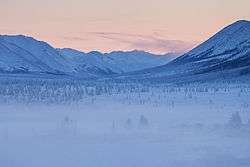
See also
- Verkhoyansk, another candidate for the "Northern Pole of Cold"
- Yakutsk, coldest major city
- Summit Camp
- Oymyakon Plateau
References
- Russian Federal State Statistics Service (2011). "Всероссийская перепись населения 2010 года. Том 1" [2010 All-Russian Population Census, vol. 1]. Всероссийская перепись населения 2010 года [2010 All-Russia Population Census] (in Russian). Federal State Statistics Service.
- "Об исчислении времени". Официальный интернет-портал правовой информации (in Russian). June 3, 2011. Retrieved January 19, 2019.
- Почта России. Информационно-вычислительный центр ОАСУ РПО. (Russian Post). Поиск объектов почтовой связи (Postal Objects Search) (in Russian)
- "World's Coldest Village Drops To -80° & The Photos Are Spectacular". InspireMore.com. January 16, 2018. Retrieved January 19, 2018.
- Pospelov, Evgeniy Mikhaylovich (1998). Географические названия мира (in Russian). Moscow. p. 307.
- Tsintsius, V. I. (1977), Сравнительный словарь тунгусо-маньчжурских языков : материалы к этимологическому словарю (in Russian), 2, Leningrad: Nauka, p. 361
- Bijal P. Trivedi (May 12, 2004). "Life Is a Chilling Challenge in Subzero Siberia". National Geographic Channel.
- "Visiting the coldest town in the world - Chilling Out - 60 Minutes Australia". June 20, 2018.
- Lebedev, Igor (1997). Aviation Lend-Lease to Russia. Nova Publishers. pp. 44–49.
- "Chilling Out – Visiting the Coldest Town in the World". 60 Minutes. June 20, 2018 – via YouTube.
- N.A. Stepanova. "On the Lowest Temperatures on Earth" (PDF). Docs.lib.noaa.gov. Archived from the original (PDF) on March 3, 2016. Retrieved March 10, 2015.
- Christopher C. Burt. "The Coldest Places on Earth". Weather Underground. Archived from the original on March 19, 2016.
- "World:Lowest Temperature". World Meteorological Organization. Archived from the original on June 16, 2010. Retrieved February 4, 2014.
- "Global Weather & Climate Extremes". World Meteorological Organization. Retrieved February 4, 2014.
- "International Glaciological Society (IGS)" (PDF). Igsoc.org. February 13, 2012. Retrieved March 10, 2015.
- "Погода и Климат - Климатический монитор: погода в Оймяконе". Pogodaiklimat.ru. Retrieved March 10, 2015.
- "Погода и Климат - Климатический монитор: погода в Верхоянске". Pogodaiklimat.ru. Retrieved March 10, 2015.
- "Погода и Климат - Климатический монитор: погода в Оймяконе". Pogodaiklimat.ru. Retrieved March 10, 2015.
- "Погода и Климат - Климатический монитор: погода в Оймяконе". Pogoda.ru.net. Retrieved March 10, 2015.
- "Погода и Климат - Климатический монитор: погода в Оймяконе". Pogoda.ru.net. Retrieved March 10, 2015.
- "Погода и Климат - Климат Оймякона". Pogodaiklimat.ru. Archived from the original on March 17, 2015. Retrieved February 16, 2017.
- "Asia: Lowest Temperature". WMO. Archived from the original on June 16, 2010. Retrieved June 19, 2010.
- "Погода в Оймяконе. Температура воздуха и осадки. Февраль 2014 г." Pogodaiklimat.ru. Retrieved February 10, 2014.
- "Ojmjakon Climate Normals 1961–1990". National Oceanic and Atmospheric Administration. Retrieved February 17, 2015.
Videos
- "Visite du village le plus froid du monde". YouTube (in French). Konbini News. February 5, 2018. Retrieved October 27, 2018.
External links
| Wikivoyage has a travel guide for Oymyakon. |
| Wikimedia Commons has media related to Oymyakon. |